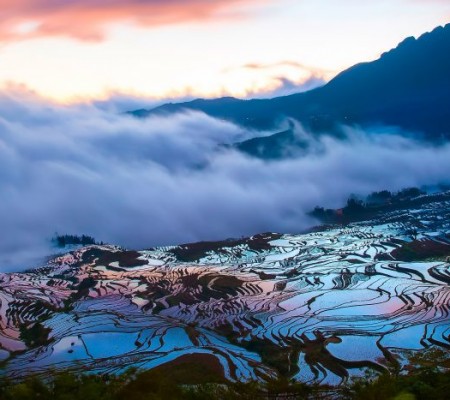
Zhengdong Sanzhai Villages in Jiangcheng County, Puer
Chinese Name: 江城县董镇镇整董村委会城子三寨
English Name: Chengzi Sanzhai Villages of Zhengdong Town in Jiangcheng County, Pu’er
The Chengzi Sanzhai Villages (城子三寨), located in Zhengdong Town (整董镇) of Jiangcheng County (江城县), Pu’er City (普洱市), consist of three traditional Dai ethnic villages: Manhe Village (曼贺), Manhejing Village (曼贺井), and Manluanzai Village (曼景寨). In 2020, these villages were listed as part of the first batch of China’s Traditional Villages (中国传统村落名录). The region is celebrated for its well-preserved Dai-style architecture and vibrant ethnic culture. The villages feature bamboo stilt houses, lush tropical rainforests, and beautiful rice paddies.
Key Features
Location: Situated approximately 56 kilometers from Jiangcheng County, the villages are set in a subtropical climate zone, ideal for various crops like corn, rubber, tea, sugarcane, and coffee.
Cultural Heritage: The villages maintain the Dai ethnic traditions, including distinctive architectural styles, festivals, and handicrafts.
Architectural Style: The villages are famous for their Dai stilt bamboo houses, designed to withstand the tropical climate.
Village Layout and Architectural Features
The three villages form a harmonious layout where fishing fields (渔田) sit at the front, stilt bamboo houses (竹楼) stand in the middle, and rainforests (雨林) surround the back. The main streets are paved with natural stone, and the houses maintain their original bamboo and wood color, blending seamlessly with the lush surrounding nature.
Stilt Houses: Traditional Dai bamboo houses with raised foundations to protect against moisture and insects. These houses have been well-preserved, with an 82% conservation rate of the stilt building complexes.
Street Design: The village paths are connected by stone slabs, leading from Mengkangluo Square to the homes.
Roofing Style: The typical roofs use the traditional Xieshan-style (歇山式) and are covered with Myanmar tiles.
Improvement of Living Environment
In 2022, the villages implemented a rural development project, improving living conditions with a series of initiatives:
House Renovations: 23 households had their homes renovated, and 1.2 km of sewage piping was installed, improving sanitation.
Environmental Beautification: Villagers planted ornamental plants such as bougainvillea and eggflower, with each household increasing their green area to an average of 15 m².
Public Infrastructure: The installation of 38 solar-powered street lamps and the construction of two public toilets have enhanced the village’s facilities.
“Three Clean, Three Changes” Initiative: Unnecessary constructions were removed, and the traditional bamboo fences were restored over 800 meters.
Cultural Heritage and Ethnic Traditions
The Dai ethnic culture is strongly preserved in the village, especially through the Dai brocade weaving (傣锦技艺) tradition, which has been recognized as an Intangible Cultural Heritage.
Traditional Weaving: 94-year-old Mi Zai Jin (咪宰金), a local craftsman, continues to weave traditional Dai skirts using a wooden sit-down loom, a practice passed down for generations. The patterns feature motifs like peacocks and Bodhi trees.
Bamboo Weaving and Crafts: Yan Wen Han (岩温罕), a skilled bamboo craftsman, creates over 100 traditional Dai fishing tools and household items. His work is sold through e-commerce platforms across the country.
The village also has an Ethnic Culture and Creative Museum (非遗文创馆) showcasing 27 volumes of palm leaf manuscripts and 45 traditional weaving tools.
Tourism Development and Economy
The villages are embracing ethnic tourism and have seen significant developments to boost the local economy:
Tourist Facilities: 34 homes have been converted into shops selling Dai clothing, bamboo crafts, and local foods. The village’s Dai clothing shop, run by Yu Duan, generates over 5,800 yuan per day during peak seasons.
Tourism Projects: Zhengdong Town has developed a “Mengkangluo” tourism brand, featuring Dai homestays and experiences like brocade weaving and rainforest trekking.
Visitor Statistics: In 2022, the village hosted 12,000 visitors, generating a total tourism income of 860,000 yuan.
Industrial Revitalization Initiatives
“Intangible Heritage + Tourism” Model: The village has established workshops for brocade weaving, dyeing, and spinning, offering various cultural products such as phone bags and table runners.
Agriculture: The village has developed 420 acres of standardized tea gardens and promotes the cultivation of medicinal herbs under the trees, boosting the annual income of each household by approximately 4,000 yuan.
Border Trade: With a 25 km border with neighboring countries, the village has set up a border trade market, allowing the sale of agricultural products like grass fruit and tea. The village cooperative has 9 cargo vehicles, generating an annual transportation income of 320,000 yuan.
Practical Information
Getting There
By Car: Zhengdong Sanzhai Villages can be reached via the Sijiang Expressway, which is about 54 kilometers from the county seat.
Public Transport: Take a bus to Zhengdong Town, followed by local transportation to the villages.
Ticket Information
Entrance Fee: Free, but certain activities such as brocade weaving workshops may require an additional fee.
Best Time to Visit
Ideal Months: November to April (Dry Season), especially during the Water Splashing Festival in April.
Travel Tips
Cultural Etiquette: Visitors should remove shoes when entering Buddhist temples.
Drones: Flying drones in the village requires prior registration.
Local Culture and Attractions
History and Traditions
The Dai people have lived in this area for over 200 years, maintaining their unique culture and customs.
Food and Dining
Traditional Dai cuisine is characterized by the use of tropical ingredients, spices, and herbs. Grilled fish, sticky rice, and spicy bamboo shoots are among the most popular dishes.
Clothing and Festivals
Dai Clothing: Traditional attire includes colorful woven fabrics and headgear, often adorned with silver ornaments.
Festivals: The Water Splashing Festival and the Dai New Year are vibrant, culturally-rich events celebrated with music, dances, and communal activities.
Architecture
The Dai bamboo stilt houses are designed for both practicality and beauty, offering protection from moisture and insects while blending seamlessly into the tropical environment.
This immersive tour offers a unique opportunity to experience the traditions, culture, and natural beauty of the Chengzi Sanzhai Villages, making it a must-visit destination for those interested in exploring the rich heritage of Yunnan’s Dai community.
Itinerary of Chengzi Sanzhai Villages
Day 1: Arrival and Exploration
Morning: Arrival and Orientation
Arrive at Zhengdong Sanzhai Villages (整董镇) in Jiangcheng County (江城县).
Check-in at local accommodations or guesthouses.
Afternoon: Village Exploration
Visit Manhe Village (曼贺): Explore the traditional Dai-style bamboo houses with their characteristic stilted structures.
Visit Manhejing Village (曼贺井): Wander through the local market and observe traditional Dai crafts and clothing.
Visit Manluanzai Village (曼景寨): Immerse yourself in the daily life of the Dai community and interact with the friendly residents.
Evening: Local Dining
Enjoy a traditional Dai dinner, featuring local specialties such as spicy bamboo shoots, grilled fish, and sticky rice with tropical fruits.
Day 2: Cultural and Historical Insights
Morning: Historical Sites and Cultural Exploration
Manhejing Group: Visit the residence of the late famous figure Zhao Cunxin, including the historic well and ancient banyan tree.
Mengkangluo Square (勐康洛广场): Admire the four ancient banyan trees, which are believed to bring good fortune and prosperity. The square is designed in the shape of a peacock and serves as a communal gathering spot.
Afternoon: Immersion in Dai Traditions
Traditional Dai Architecture: Tour the traditional Dai houses and learn about their construction methods and cultural significance.
Dai Festivals and Customs: If your visit coincides with a Dai festival, such as the Water Splashing Festival, participate in the festivities, and experience traditional dances, music, and rituals.
Evening: Relaxation and Local Experience
Dinner at a Local Dai Restaurant: Try more regional dishes, and enjoy traditional Dai music performances.
Evening Stroll: Walk through the village streets, enjoying the peaceful and relaxed ambiance.
Day 3: Nature and Craftsmanship
Morning: Nature and Environment
Visit Manpan Village (曼滩村): Explore the picturesque surroundings, where traditional bamboo houses seamlessly blend with the natural landscape of rivers, rainforests, and rice paddies.
Nature Walk: Take a guided tour through local trails, appreciating the lush scenery and rich biodiversity of the area.
Afternoon: Crafts and Local Industries
Visit Local Craft Workshops: Observe traditional Dai crafts, such as weaving and wood carving.
Explore Agricultural Practices: Learn about local farming methods and the cultivation of subtropical crops, including rubber, tea, and rice.
Evening: Farewell Dinner
Dinner and Reflection: Share a final meal with local villagers, reflecting on your experiences and learning about their way of life.
Departure: Prepare for departure and travel back to your next destination or home.
Local Culture and Attractions
History and Heritage
The Dai people have inhabited these villages for over 200 years, preserving their rich cultural heritage and traditions.
Food and Dining
Traditional Dai cuisine is rich in spices, herbs, and tropical ingredients. Must-try dishes include:
Grilled fish and sticky rice.
Spicy bamboo shoots and wild herbs.
Clothing
Traditional Dai attire is made from colorful woven fabrics. Headgear is often adorned with silver ornaments, showcasing the distinct cultural identity of the Dai people.
Customs and Traditions
Dai festivals such as the Water Splashing Festival and Dai New Year are celebrated with vibrant ceremonies, communal dancing, music, and rituals.
Architecture
The Dai houses are stilted bamboo structures, designed to cope with the local climate and terrain. The elevated design provides protection from moisture and insects, making it ideal for the tropical environment.
Festivals
Water Splashing Festival (泼水节): A joyous celebration welcoming the new year in the Dai lunar calendar.
Dai New Year (傣族新年): Celebrated with elaborate ceremonies, traditional dances, and feasts.
Crafts
The village is renowned for its traditional Dai handicrafts:
Brocade weaving (傣锦).
Wood carving and bamboo weaving.
Traditional Dai embroidery.
Religion
The Dai people practice Theravada Buddhism, which deeply influences their festivals, daily life, and community rituals.
Language
The Dai language is spoken by the local population, though many villagers also speak Mandarin.
This tour will offer a comprehensive, immersive experience into the culture, heritage, and natural beauty of the Chengzi Sanzhai Villages, allowing you to explore one of Pu’er‘s most fascinating ethnic communities.

 7 Days GolfingTour
7 Days GolfingTour
 8 Days Group Tour
8 Days Group Tour
 8 Days Yunnan Tour
8 Days Yunnan Tour
 7 Days Shangri La Hiking
7 Days Shangri La Hiking
 11 Days Yunnan Tour
11 Days Yunnan Tour
 6 Days Yuanyang Terraces
6 Days Yuanyang Terraces
 11 Days Yunnan Tour
11 Days Yunnan Tour
 8 Days South Yunnan
8 Days South Yunnan
 7 Days Tea Tour
7 Days Tea Tour
 8 Days Muslim Tour
8 Days Muslim Tour
 12 Days Self-Driving
12 Days Self-Driving
 4 Days Haba Climbing
4 Days Haba Climbing
 Tiger Leaping Gorge
Tiger Leaping Gorge
 Stone Forest
Stone Forest
 Yunnan-Tibet
Yunnan-Tibet
 Hani Rice Terraces
Hani Rice Terraces
 Kunming
Kunming
 Lijiang
Lijiang
 Shangri-la
Shangri-la
 Dali
Dali
 XishuangBanna
XishuangBanna
 Honghe
Honghe
 Kunming
Kunming
 Lijiang
Lijiang
 Shangri-la
Shangri-la
 Yuanyang Rice Terraces
Yuanyang Rice Terraces
 Nujiang
Nujiang
 XishuangBanna
XishuangBanna
 Spring City Golf
Spring City Golf
 Snow Mountain Golf
Snow Mountain Golf
 Stone Mountain Golf
Stone Mountain Golf















